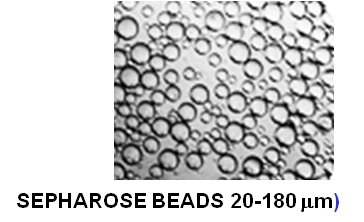While the initial work on BI was limited to the use of agarose-based beads, because of their transparency, wide availability, and low cost, other polymer beads were used with success in trace metal assays (Miro 2008), while Cytodex (Hodder 1999) and Cytopore (Schultz 2002) beads were used as carriers for BI-based cellular assays. In this section a brief overview of ligands commercially available on Sepharose and Sephadex beads offers insight and almost limitless opportunities for development of novel assays for organic compounds, enzymes, antigens, antibodies, DNA, RNA and other biomolecules, as well as pathogens and bacteria. Sepharose is made of cross-linked, purified polysaccharide (galactose) derived from seaweed, while Sephadex is made of cross-linked microbial polysaccharide (glucose). Both beaded supports are widely used for affinity chromatography. These microspheres (size 20 to 180 μm) are available with various degrees of crosslinking (4B or 6B) and the following immobilized functional groups:
Protein A –from S. aureus, binds mammalian immunoglobulins (IgG) by their Fc region.
Protein G –from S. G148, binds a range of immunoglobulins, including rat and goat IgG.
Avidin – from egg white, binds D-biotin, useful for attaching biotinylated ligands.
Streptavidin – from S. avidinii, for srong attachment of biotinylated ligands.
While these functionalities are used to capture biomolecules with high degrees of selectivity, preactivated Sephadex, with functionality allowing for easy immobilization of ligands such as proteins, carbohydrates or nucleic acids and designed as support for affinity chromatography, opens an even wider area for Bead Injection format as it allows the user to tailor bead functionality to practically any target biomolecule of choice.
Also, Sepharose and Sephadex are availabe as anion exchangers – strong (trimethylaminopropyl) or weak (amino) for binding of anions, as cation exchangers – strong (sulphonate) or weak (carboxylic) for binding of cations as well as nonpolar – from strong (octadecyl, C-18) to weak (octyl, C-8) for binding of uncharged species.
Beads and Bioligands
3.2.2.










